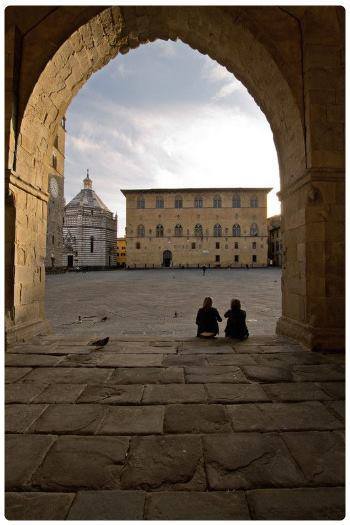|
What
to see in Pistoia - The 20 places not to be missed
|
Pistoia
amazes, surprisingly new in the Italian tourist
scene and already praised by history and
architecture in the world of art. A few steps away
from the Florentine capital and not far from the spa
resorts and less than 50 minutes from Pisa airport,
Pistoia is an additional reason to visit Tuscany,
which is not only made up of well known cities and
undulating hills so famous abroad.
|
|
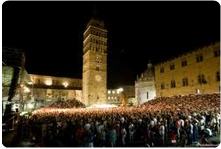 Not expected so
much beauty from Pistoia, medieval city, first Roman
town hall, a little out of the circuit of mass
tourism, unjustly underestimated...The
look rises high in the city, it focuses on the ancient monuments, the
medieval ones developed in
Romanesque and
Gothic art and
then those of the
Italian Renaissance,
which they have produced so much and which gradually meet in an appetite to
know, among stories, legends and everyday life lived before us. Sitting at
the foot of the nearby Apennine hills, Pistoia is an enchanted corner of
Italian memory. We invite you to visit it through some of its most
characteristic monuments and places: Not expected so
much beauty from Pistoia, medieval city, first Roman
town hall, a little out of the circuit of mass
tourism, unjustly underestimated...The
look rises high in the city, it focuses on the ancient monuments, the
medieval ones developed in
Romanesque and
Gothic art and
then those of the
Italian Renaissance,
which they have produced so much and which gradually meet in an appetite to
know, among stories, legends and everyday life lived before us. Sitting at
the foot of the nearby Apennine hills, Pistoia is an enchanted corner of
Italian memory. We invite you to visit it through some of its most
characteristic monuments and places:
Piazza
Duomo di Pistoia (Dome Square)
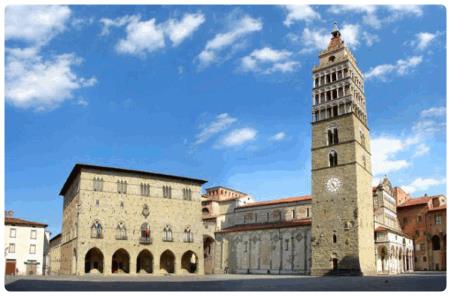 The
early origins of the main square of Pistoia can be traced back to the period
of ancient Rome. In that distant period, and a short distance from this same
place, the extension of the Via Cassia towards the north was built,
precisely at the intersection of the Decumano Maximus (the road that
ran east-west) and the Cardo Maximus (the pivotal point, that is the road
that ran north-south), the two main lines of ancient Roman urbanism. The two
routes currently correspond to the Via degli Orafi and Via Bracciolini.
Pistoia already existed as an Etruscan settlement, but it was with
the Romans that the city developed; the first certain testimonies are
dated from the second century BC and speak of the city as the main support
point of the Roman army in the fight against the Ligurians. With the Romans,
the square became the nerve centre of the small town that was being formed,
so much so that a small Forum and a noble residence were built nearby. With
the Lombards, in fact, the urban heart of the city moved nearby, in
today's Piazza della Sala. Today, Piazza del Duomo di Pistoia is the result
of centuries of history and is surrounded by architectural monuments that
more than others have marked its urban growth: the Cathedral of San Zeno (XI
century), the Baptistery of San Giovanni in Corte (XIV century), the Palace
of Bishops (XI century), the Palazzo Pretorio (XIV century), the Town Hall (XII
century). The
early origins of the main square of Pistoia can be traced back to the period
of ancient Rome. In that distant period, and a short distance from this same
place, the extension of the Via Cassia towards the north was built,
precisely at the intersection of the Decumano Maximus (the road that
ran east-west) and the Cardo Maximus (the pivotal point, that is the road
that ran north-south), the two main lines of ancient Roman urbanism. The two
routes currently correspond to the Via degli Orafi and Via Bracciolini.
Pistoia already existed as an Etruscan settlement, but it was with
the Romans that the city developed; the first certain testimonies are
dated from the second century BC and speak of the city as the main support
point of the Roman army in the fight against the Ligurians. With the Romans,
the square became the nerve centre of the small town that was being formed,
so much so that a small Forum and a noble residence were built nearby. With
the Lombards, in fact, the urban heart of the city moved nearby, in
today's Piazza della Sala. Today, Piazza del Duomo di Pistoia is the result
of centuries of history and is surrounded by architectural monuments that
more than others have marked its urban growth: the Cathedral of San Zeno (XI
century), the Baptistery of San Giovanni in Corte (XIV century), the Palace
of Bishops (XI century), the Palazzo Pretorio (XIV century), the Town Hall (XII
century).
Top
Duomo di Pistoia (Cathedral
of Pistoia)
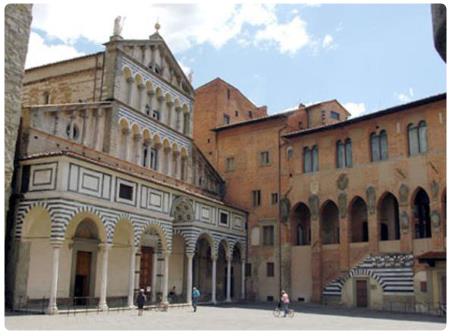 The
bell tower of the Cathedral of San Zeno, dedicated to the "Moorish
Bishop", can be seen from almost all of Pistoia. It must have always been a
point of reference in these parts, so as not to get lost and not to lose the
soul. The cathedral has an ancient history, which is lost almost to the
limits of the end of the Roman Empire, an era in which the certainties
accumulated by centuries of Roman times vanished, leaving the field to the
only foothold that seemed to remain, the church, in an era of invasions and
destruction that followed one another relentlessly by Goths, Byzantines,
Lombards and Franks. The current building of the cathedral, certainly rose
above a religious building built during the domination of the Longobards
of the city, who made it their gastalized, a center of administrative
and religious power, partly autonomous... Continue reading on the
Cathedral of Pistoia. The
bell tower of the Cathedral of San Zeno, dedicated to the "Moorish
Bishop", can be seen from almost all of Pistoia. It must have always been a
point of reference in these parts, so as not to get lost and not to lose the
soul. The cathedral has an ancient history, which is lost almost to the
limits of the end of the Roman Empire, an era in which the certainties
accumulated by centuries of Roman times vanished, leaving the field to the
only foothold that seemed to remain, the church, in an era of invasions and
destruction that followed one another relentlessly by Goths, Byzantines,
Lombards and Franks. The current building of the cathedral, certainly rose
above a religious building built during the domination of the Longobards
of the city, who made it their gastalized, a center of administrative
and religious power, partly autonomous... Continue reading on the
Cathedral of Pistoia.
Top
Palazzo
del Comune di Pistoia (Town All)
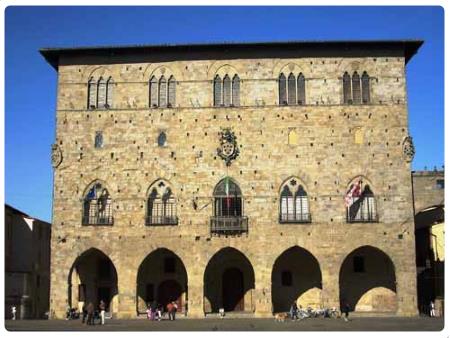 Recognizable
in the large Piazza del Duomo, the Palazzo del Municipio (Town All)
is dated XIII century and probably was built by the then city mayor,
Giano della Bella (the building is also called Palazzo di Giano).
The present appearance of the palace is the result of several architectural
developments: it is a 14th century original, while previously the portico
had already been built in the main external façade (the addition of the
fifth archway is later) and the elevation of the second floor. Subsequently,
the renovation was concentrated in the interiors.... Continue reading on the
Town All of Pistoia. Recognizable
in the large Piazza del Duomo, the Palazzo del Municipio (Town All)
is dated XIII century and probably was built by the then city mayor,
Giano della Bella (the building is also called Palazzo di Giano).
The present appearance of the palace is the result of several architectural
developments: it is a 14th century original, while previously the portico
had already been built in the main external façade (the addition of the
fifth archway is later) and the elevation of the second floor. Subsequently,
the renovation was concentrated in the interiors.... Continue reading on the
Town All of Pistoia.
Top
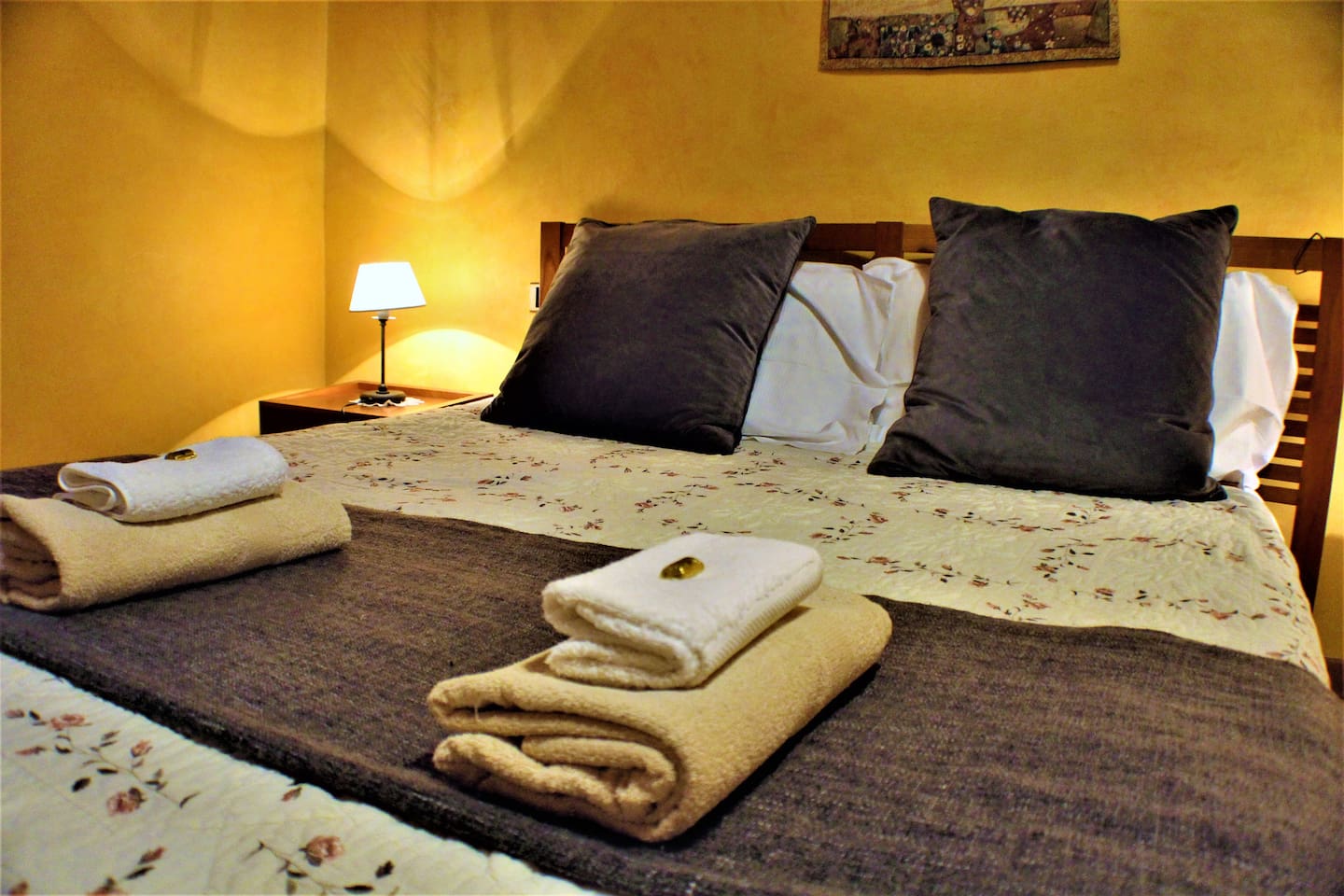
★ Apt 75 mq | heart of Pistoia | 100 mt to the CathedralPistoia, Tuscany, Italia
In Pistoia, which was the capital of culture 2017, we will
welcome you in the heart of the city: apartment with fine
finishes, a double bedroom, 1 single bedroom, beamed
ceiling, 50 meters from Piazza del Duomo, wifi and smart tv,
with Netflix, Amazon Prime.......
|
Baptistery of San Giovanni
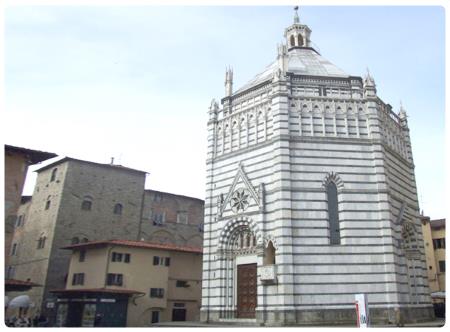 The Baptistery of San Giovanni in Pistoia dates back to the mid-14th
century and stands on the area of the ancient baptismal church of Santa
Maria and San Giovanni in Corte. The position opposite the Cathedral of
Pistoia is quite usual for this type of church in the early Christian
Romanesque period. It was born in a period of high construction experiences
and can be considered an emblematic work of Gothic Tuscan architecture. It
is also one of the last examples of a building designed to house exclusively
the baptismal font... Read on the
Baptistery of San Giovanni in Pistoia. The Baptistery of San Giovanni in Pistoia dates back to the mid-14th
century and stands on the area of the ancient baptismal church of Santa
Maria and San Giovanni in Corte. The position opposite the Cathedral of
Pistoia is quite usual for this type of church in the early Christian
Romanesque period. It was born in a period of high construction experiences
and can be considered an emblematic work of Gothic Tuscan architecture. It
is also one of the last examples of a building designed to house exclusively
the baptismal font... Read on the
Baptistery of San Giovanni in Pistoia.
Top
Bishops' Palace
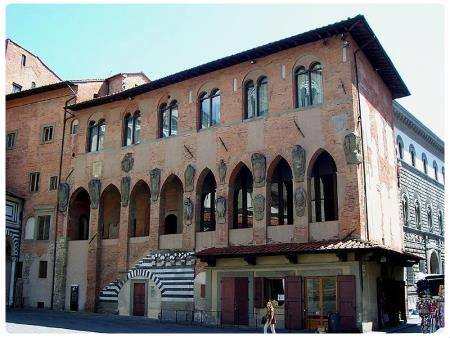
For almost
eight centuries, and until 1782, this was the
residence of the bishops of Pistoia. In 1786 it was
sold to private individuals, thus beginning a period
of profound transformation. It was only in 1980 that
the palace, following a complex restoration project,
acquired a new value of testimony. The traces of the
numerous interventions that have taken place over
the centuries are made evident and new exhibition
spaces are equipped. Thus the entire volume of the
Sacristy is retrieved, which saw the sacrilegious
theft of Vanni Fucci, remembered by Dante
(Inferno, XXIV, 138)...Read on the
Bishops
Palace in Pistoia.
Top
Palazzo
Pretorio di Pistoia (Palazzo del Podestà)
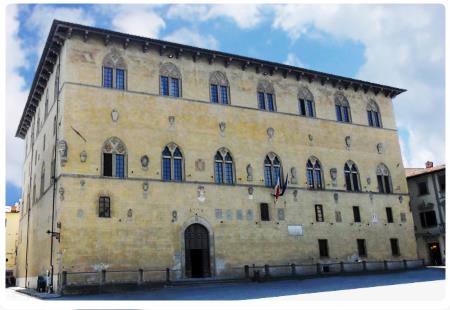 The
actual Palace of the Prefecture of Pistoia is much older. The
building originated in medieval times, built to house the then Municipal
Podestà, then replaced by the Florentine Commissioners during the domination
of the Medici Florence. It represented the third most important power in the
city, the judiciary, alongside both the religious and civil powers of the
church and the Town Hall, respectively. In the 19th century, when the
Podestarili magistrates were abolished, the palace became the seat of the
Collegial Court and later the Royal Court of First Instance. His
visit focuses in particular on the inner courtyard, covered with vaulted
ceilings and decorated with a series of frescoes dating back to the
fifteenth century and finished in the nineteenth century, depicting the
coats of arms of the mayors and commissioners in service in the palace. The
actual Palace of the Prefecture of Pistoia is much older. The
building originated in medieval times, built to house the then Municipal
Podestà, then replaced by the Florentine Commissioners during the domination
of the Medici Florence. It represented the third most important power in the
city, the judiciary, alongside both the religious and civil powers of the
church and the Town Hall, respectively. In the 19th century, when the
Podestarili magistrates were abolished, the palace became the seat of the
Collegial Court and later the Royal Court of First Instance. His
visit focuses in particular on the inner courtyard, covered with vaulted
ceilings and decorated with a series of frescoes dating back to the
fifteenth century and finished in the nineteenth century, depicting the
coats of arms of the mayors and commissioners in service in the palace.
Piazza del Duomo 10
area: historical centre
Tel: +39 0573 0573 9791
Top
Piazza
della Sala
 Behind
the Piazza del Duomo and precisely the Baptistery, we arrive at another
historic square of Pistoia, that of the Hall (as indicated since the
Longobard period), from the name given to the administrative palace of the
public (the Palazzo del Gastaldo), once present here. Traditionally, this is
the area dedicated to the city's market, a place where goods and products
are exchanged and which is still held daily, surrounded by traditional shops
and artisan workshops... Read on
Piazza della Sala. Behind
the Piazza del Duomo and precisely the Baptistery, we arrive at another
historic square of Pistoia, that of the Hall (as indicated since the
Longobard period), from the name given to the administrative palace of the
public (the Palazzo del Gastaldo), once present here. Traditionally, this is
the area dedicated to the city's market, a place where goods and products
are exchanged and which is still held daily, surrounded by traditional shops
and artisan workshops... Read on
Piazza della Sala.
Top
Church of San Giovanni
Fuorcivitas
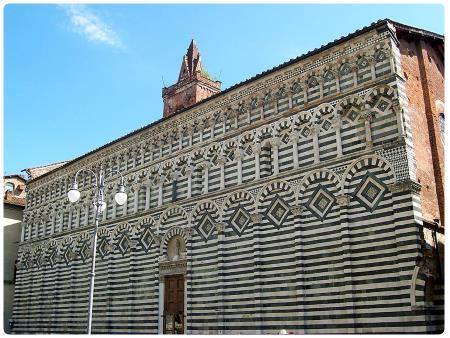 The
Church of San Giovanni Fuorcivitas is so called because it was built
outside the medieval walls of the city, flanked by its northern side (the
best known), although today its position appears more than central, being
located a few meters from the Piazza del Duomo. As soon as the Lombards
converted to Catholicism, they built this church: this happened around the
eighth century. Inside, the light rains poorly from the windows installed.
In this church there are three highly admired works of excellent sculpture,
known all over the world: the Pergamon (Pulpit), by Fra Guglielmo
da Pisa; the Visitation, in terra cotta invetriata, by Andrea
della Robbia; the Acquasantiera di Giovanni Pisano...
Continue reading on the
Church of San Giovanni Fuorcivitas. The
Church of San Giovanni Fuorcivitas is so called because it was built
outside the medieval walls of the city, flanked by its northern side (the
best known), although today its position appears more than central, being
located a few meters from the Piazza del Duomo. As soon as the Lombards
converted to Catholicism, they built this church: this happened around the
eighth century. Inside, the light rains poorly from the windows installed.
In this church there are three highly admired works of excellent sculpture,
known all over the world: the Pergamon (Pulpit), by Fra Guglielmo
da Pisa; the Visitation, in terra cotta invetriata, by Andrea
della Robbia; the Acquasantiera di Giovanni Pisano...
Continue reading on the
Church of San Giovanni Fuorcivitas.
Top
Forteguerriana Library
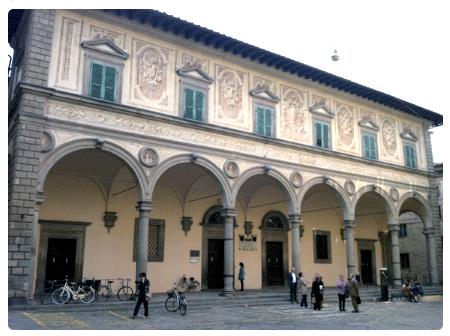 The
Forteguerriana Library stands in Piazzetta della Sapienza, so called
because it is in front of the library, which was initially called "Pia Casa
della Sapienza". It was founded following the donation made on 23 August
1473 by Cardinal, diplomat and warrior Niccolò Forteguerri, for the
young scholar of his city. On this Pia Casa della Sapienza it was decided in
1533 to found a library, increasing the one already very richly offered by
the Cardinal, with the copious collection of the canon Sozzomeno (1387-
1458), an illustrious Grecist and Latinist from Pistoia, so that the "Pia
Casa" became the present Forteguerriana Library with more than 100,000
volumes, without counting the many and valuable incunabula. The
Forteguerriana Library stands in Piazzetta della Sapienza, so called
because it is in front of the library, which was initially called "Pia Casa
della Sapienza". It was founded following the donation made on 23 August
1473 by Cardinal, diplomat and warrior Niccolò Forteguerri, for the
young scholar of his city. On this Pia Casa della Sapienza it was decided in
1533 to found a library, increasing the one already very richly offered by
the Cardinal, with the copious collection of the canon Sozzomeno (1387-
1458), an illustrious Grecist and Latinist from Pistoia, so that the "Pia
Casa" became the present Forteguerriana Library with more than 100,000
volumes, without counting the many and valuable incunabula.
Top
Rospigliosi Palace
- Diocesan Museum
 The
Rospigliosi Palace in Pistoia is located in Via Ripa del Sale, which
opens in the Piazza del Duomo between Palazzo Comunale and one side of the
Cathedral. On the noble floor of the palace, built in the mid-16th century
with the renovation of pre-existing buildings, the very composite collection
of the diocesan museum has been on display (since 1989). Books, miniatures,
sacred furnishings, goldsmith's objects and sculptures from the diocese.
Open to the visit is also the one, which is commonly called the apartment of
Pope Clement IX. The Cathedral Museum, which was previously located
in the Bishop's Palace, has been remodelled in this building. which presents,
among other things, valuable examples of Gothic goldsmith's art and various
reliquaries. The
Rospigliosi Palace in Pistoia is located in Via Ripa del Sale, which
opens in the Piazza del Duomo between Palazzo Comunale and one side of the
Cathedral. On the noble floor of the palace, built in the mid-16th century
with the renovation of pre-existing buildings, the very composite collection
of the diocesan museum has been on display (since 1989). Books, miniatures,
sacred furnishings, goldsmith's objects and sculptures from the diocese.
Open to the visit is also the one, which is commonly called the apartment of
Pope Clement IX. The Cathedral Museum, which was previously located
in the Bishop's Palace, has been remodelled in this building. which presents,
among other things, valuable examples of Gothic goldsmith's art and various
reliquaries.
Top
Churches of Pistoia
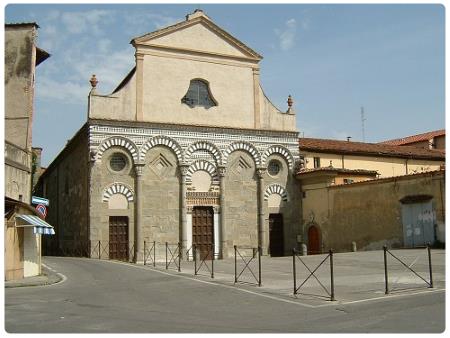 There
are numerous churches of architectural and historical interest in Pistoia
and all contain an important view of the Pistoia and medieval and
Renaissance Tuscany. In addition to those mentioned, the visit to the
church of San Pier Maggiore (built in Longobard period and known for the
tradition of the so-called Mystical Marriage of Pistoia, a ritual
that saw the bishop of the diocese - after a long procession that began from
Porta Lucchese - exchange the rings with the abbess of the convent of San
Pietro; the church of San Bartolomeo in Pantano (originary of the
eighth century), which is particularly appreciated for its interior and for
the architrave, the beautiful pulpit and the marble reliefs sculpted; the
parish church of Sant' Andrea (VIII century), famous for the Pulpit
of Sant'Andrea, a fourteenth-century masterpiece sculpted by Giovanni
Pisano; the Church of San Michele in Cioncio (XII-XIII century), so
called because it probably served the wool workers - as a pepper, that is,
the workers' wages; the church of Santa Maria delle Grazie (XV
century), which was probably built by the Pistoiese architect Ventura
Vitoni (and not from the Florentine one, Michelozzo) and which is also
known as the Sanctuary of the Madonna del L bed, because it served as a
chapel of the nearby Ceppo hospital; and which is also known as the
Sanctuary of the Madonna del Letto (Mary of the Bed), because it
served as a chapel of the nearby Ceppo hospital; the Church of Santissima
Annunziata di Pistoia (originally dated 13th century), which today
appears in Baroque style because of the numerous rehashes in past historical
epochs. Inside there are numerous works of art, including the' Nativity'
of Lodovico Cardi known as Cigoli; the Church of the Holy
Spirit (13th century) in Baroque style. There
are numerous churches of architectural and historical interest in Pistoia
and all contain an important view of the Pistoia and medieval and
Renaissance Tuscany. In addition to those mentioned, the visit to the
church of San Pier Maggiore (built in Longobard period and known for the
tradition of the so-called Mystical Marriage of Pistoia, a ritual
that saw the bishop of the diocese - after a long procession that began from
Porta Lucchese - exchange the rings with the abbess of the convent of San
Pietro; the church of San Bartolomeo in Pantano (originary of the
eighth century), which is particularly appreciated for its interior and for
the architrave, the beautiful pulpit and the marble reliefs sculpted; the
parish church of Sant' Andrea (VIII century), famous for the Pulpit
of Sant'Andrea, a fourteenth-century masterpiece sculpted by Giovanni
Pisano; the Church of San Michele in Cioncio (XII-XIII century), so
called because it probably served the wool workers - as a pepper, that is,
the workers' wages; the church of Santa Maria delle Grazie (XV
century), which was probably built by the Pistoiese architect Ventura
Vitoni (and not from the Florentine one, Michelozzo) and which is also
known as the Sanctuary of the Madonna del L bed, because it served as a
chapel of the nearby Ceppo hospital; and which is also known as the
Sanctuary of the Madonna del Letto (Mary of the Bed), because it
served as a chapel of the nearby Ceppo hospital; the Church of Santissima
Annunziata di Pistoia (originally dated 13th century), which today
appears in Baroque style because of the numerous rehashes in past historical
epochs. Inside there are numerous works of art, including the' Nativity'
of Lodovico Cardi known as Cigoli; the Church of the Holy
Spirit (13th century) in Baroque style.
Top
Via
degli Orafi (Goldsmiths'
Street)
 We
are in one of the oldest streets of the city, developed from the Upper
Decumanus of Roman Pistoia, the road axis oriented east-west direction in
the urban planning of the period. From here, Pistoia connected with Lucca
through Porta Lucensis. The current name derives from the many
goldsmiths' shops traditionally present for a long time, despite changing
the name several times depending on the role played in the various
historical epochs of the city: in the past it was, for example, called
via Taberna, today remained in a part of it, perhaps for the taverns
present for the benefit of the many wayfarers who crossed it. Along the
street, important buildings have succeeded each other in time and are still
present today, for example the Palazzo Bracciolini Api (inspired by
the aesthetic canons of the Medici period) located a few steps away in the
current Via dei Bracciolini, We
are in one of the oldest streets of the city, developed from the Upper
Decumanus of Roman Pistoia, the road axis oriented east-west direction in
the urban planning of the period. From here, Pistoia connected with Lucca
through Porta Lucensis. The current name derives from the many
goldsmiths' shops traditionally present for a long time, despite changing
the name several times depending on the role played in the various
historical epochs of the city: in the past it was, for example, called
via Taberna, today remained in a part of it, perhaps for the taverns
present for the benefit of the many wayfarers who crossed it. Along the
street, important buildings have succeeded each other in time and are still
present today, for example the Palazzo Bracciolini Api (inspired by
the aesthetic canons of the Medici period) located a few steps away in the
current Via dei Bracciolini,
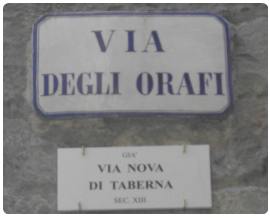 and
buildings in Art Nouveau Art Nouveau Art Nouveau style. The latter are a
surprising discovery in Pistoia, built thanks to the passion of a travelling
merchant of Lombard origin who later became a prominent element in the city
community of the early twentieth century: this is the case, for example, of
the Cinema Eden in Pistoia (formerly Galleria Vittorio Emanuele in Pistoia),
located at number 54 in Via degli Orafi and then connected with the nearby
Via dell'Abbondanza and Via della Posta Vecchia. The gallery is the result
of a great participation of artists and workers from Pistoia (the project
was carried out with the collaboration of Ugo di Casanova,
Paglianti and Michelucci for wrought iron ornaments). The
building served both as an exhibition gallery and theatre for variety and
film shows. and
buildings in Art Nouveau Art Nouveau Art Nouveau style. The latter are a
surprising discovery in Pistoia, built thanks to the passion of a travelling
merchant of Lombard origin who later became a prominent element in the city
community of the early twentieth century: this is the case, for example, of
the Cinema Eden in Pistoia (formerly Galleria Vittorio Emanuele in Pistoia),
located at number 54 in Via degli Orafi and then connected with the nearby
Via dell'Abbondanza and Via della Posta Vecchia. The gallery is the result
of a great participation of artists and workers from Pistoia (the project
was carried out with the collaboration of Ugo di Casanova,
Paglianti and Michelucci for wrought iron ornaments). The
building served both as an exhibition gallery and theatre for variety and
film shows.
Top
Fortezza
di Santa Barbara di Pistoia
Piazza della Resistenza
Area: poco fuori il centro storico e a destra della stazione ferroviaria
centrale di Pistoia
Tel: +39 0573 24212
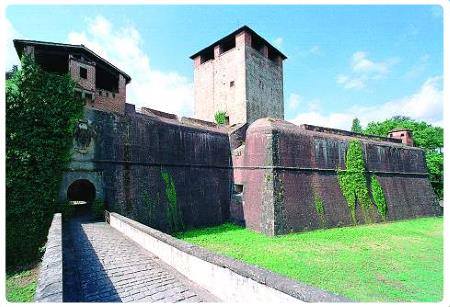 La fortezza di Santa Barbara è parte delle
antiche mura di Pistoia, oggi rimaste in un breve tratto urbano della
città, tra cui il presente. Un tempo e in epoche successive la città era
infatti circondata da tre cortine murarie, di cui la prima completata verso
nel lontano VIII secolo. L'ultima cerchia, oggi riconoscibile tra i viali
Matteotti ed Arcadia, venne innalzata dopo la conquista di Pistoia da parte
dei Fiorentini nel 1306. Prende il nome probabilmente da una cappella
situata nei pressi e venne costruita su un preesistente fortilizio datato
prima metà del XIV secolo. L'attuale fu realizzata secondo il progetto
architettonico di Nanni Unghero per volere di Cosimo I de' Medici
durante
nella politica di potenziamento
delle fortezze, segno visibile e tangibile del potere militare della casata.
La struttura si presenta a pianta quadrilatera, bastionata da possenti mura
in mattoni rossi, propria dell'edilizia militare del Granducato di Toscana.
Il suo aspetto odierno non cambia di molto dalle sue antiche origini, grazie
al fatto che il solo assedio a cui dovete far fronte fu nella seconda metà
del Seicento durante il conflitto con le truppe pontificie nel cosiddetto 'assalto
dei Barberini', di papa Urbano VIII, il cui vero nome era
Maffeo Barberini (si conservano numerose testimonianze iconografiche
dell'episodio tra cui un'opera attribuita ad Alessio Gimignani
custodita nel Museo Civico di Pistoia). Il conflitto contrapponeva
Ferdinando II, granduca di Toscana, al papa Urbano VIII e alla famiglia
dei Barberini, che avevano occupato l'antico ducato di Castro e
Ronciglione, retto dai Farnese. Nel Settecento, avendo perduto la
funzione militare, la fortezza venne dapprima assunta a ruolo di caserma e
quindi di carcere. La fortezza di Santa Barbara è parte delle
antiche mura di Pistoia, oggi rimaste in un breve tratto urbano della
città, tra cui il presente. Un tempo e in epoche successive la città era
infatti circondata da tre cortine murarie, di cui la prima completata verso
nel lontano VIII secolo. L'ultima cerchia, oggi riconoscibile tra i viali
Matteotti ed Arcadia, venne innalzata dopo la conquista di Pistoia da parte
dei Fiorentini nel 1306. Prende il nome probabilmente da una cappella
situata nei pressi e venne costruita su un preesistente fortilizio datato
prima metà del XIV secolo. L'attuale fu realizzata secondo il progetto
architettonico di Nanni Unghero per volere di Cosimo I de' Medici
durante
nella politica di potenziamento
delle fortezze, segno visibile e tangibile del potere militare della casata.
La struttura si presenta a pianta quadrilatera, bastionata da possenti mura
in mattoni rossi, propria dell'edilizia militare del Granducato di Toscana.
Il suo aspetto odierno non cambia di molto dalle sue antiche origini, grazie
al fatto che il solo assedio a cui dovete far fronte fu nella seconda metà
del Seicento durante il conflitto con le truppe pontificie nel cosiddetto 'assalto
dei Barberini', di papa Urbano VIII, il cui vero nome era
Maffeo Barberini (si conservano numerose testimonianze iconografiche
dell'episodio tra cui un'opera attribuita ad Alessio Gimignani
custodita nel Museo Civico di Pistoia). Il conflitto contrapponeva
Ferdinando II, granduca di Toscana, al papa Urbano VIII e alla famiglia
dei Barberini, che avevano occupato l'antico ducato di Castro e
Ronciglione, retto dai Farnese. Nel Settecento, avendo perduto la
funzione militare, la fortezza venne dapprima assunta a ruolo di caserma e
quindi di carcere.
Fortress of Santa Barbara of
Pistoia
Piazza della Resistenza
Area: just outside the historic centre and to the right of the central
railway station of Pistoia
Tel: +39 0573 0573 24212
 The
fortress of Santa Barbara is part of the ancient walls of Pistoia,
which today remain in a short urban stretch of the city, including the
present. At one time and in later times the city was surrounded by three
curtains of walls, the first of which was completed towards the far eighth
century. The last circle, now recognizable between the avenues Matteotti and
Arcadia, was raised after the conquest of Pistoia by the Florentines in
1306. It probably takes its name from a chapel located near it and was built
on a pre-existing fortress dating from the first half of the fourteenth
century. The present one was built according to the architectural project of
Nanni Unghero at the behest of Cosimo I de' Medici during the
policy of strengthening the fortresses, a visible and tangible sign of the
military power of the family. The structure has a quadrilateral plan,
bastioned by powerful walls in red brick, typical of the military building
of the Grand Duchy of Tuscany. Its present-day appearance does not change
much from its ancient origins, thanks to the fact that the only siege you
have to face was in the second half of the seventeenth century during the
conflict with the pontifical troops in the so-called' assault of
Barberini', by Pope Urban VIII, whose real name was Maffeo
Barberini (numerous iconographic testimonies of the episode, including a
work attributed to Alessio Gimignani are kept in the Civic Museum
of Pistoia). The conflict contrasted Ferdinand II, Grand Duke of
Tuscany, with Pope Urban VIII and the Barberini family, who had occupied the
ancient Duchy of Castro and Ronciglione, ruled by the Farnese family.
In the eighteenth century, having lost its military function, the fortress
was first taken on as a barracks and then as a prison. The
fortress of Santa Barbara is part of the ancient walls of Pistoia,
which today remain in a short urban stretch of the city, including the
present. At one time and in later times the city was surrounded by three
curtains of walls, the first of which was completed towards the far eighth
century. The last circle, now recognizable between the avenues Matteotti and
Arcadia, was raised after the conquest of Pistoia by the Florentines in
1306. It probably takes its name from a chapel located near it and was built
on a pre-existing fortress dating from the first half of the fourteenth
century. The present one was built according to the architectural project of
Nanni Unghero at the behest of Cosimo I de' Medici during the
policy of strengthening the fortresses, a visible and tangible sign of the
military power of the family. The structure has a quadrilateral plan,
bastioned by powerful walls in red brick, typical of the military building
of the Grand Duchy of Tuscany. Its present-day appearance does not change
much from its ancient origins, thanks to the fact that the only siege you
have to face was in the second half of the seventeenth century during the
conflict with the pontifical troops in the so-called' assault of
Barberini', by Pope Urban VIII, whose real name was Maffeo
Barberini (numerous iconographic testimonies of the episode, including a
work attributed to Alessio Gimignani are kept in the Civic Museum
of Pistoia). The conflict contrasted Ferdinand II, Grand Duke of
Tuscany, with Pope Urban VIII and the Barberini family, who had occupied the
ancient Duchy of Castro and Ronciglione, ruled by the Farnese family.
In the eighteenth century, having lost its military function, the fortress
was first taken on as a barracks and then as a prison.
Top
Palazzo Fabroni e Museo Fernando Melani
Via Sant'Andrea, 18
Area: centro storico
Tel: +39 0573 371611 (per prenotazioni +39
0573 371296)
 Palazzo Fabroni viene edificato intorno al
XIV secolo, anno della sua costruzione, come proprietà dei Dondori,
famiglia nota nella Pistoia medievale. L'attuale è il risultato di una
profonda ristrutturazione voluta da una seconda famiglia, i Fabroni,
che ne acquistarono la proprietà durante il XVII secolo e che la
conservarono fino alla metà del XIX secolo, fino a quando non venne poi
acquista dal comune di Pistoia. Oggi il palazzo è parte di un percorso
artistico d'arte contemporanea tra i più Palazzo Fabroni viene edificato intorno al
XIV secolo, anno della sua costruzione, come proprietà dei Dondori,
famiglia nota nella Pistoia medievale. L'attuale è il risultato di una
profonda ristrutturazione voluta da una seconda famiglia, i Fabroni,
che ne acquistarono la proprietà durante il XVII secolo e che la
conservarono fino alla metà del XIX secolo, fino a quando non venne poi
acquista dal comune di Pistoia. Oggi il palazzo è parte di un percorso
artistico d'arte contemporanea tra i più
 importanti in città, in un
misto omogeneo che accoglie stili e arredi nobiliari d'epoca con forme
fluide di arti appartenenti a tempi più recenti. Il secondo piano del
Palazzo si presta ad ospitare la collezione permanente di arte contemporanea
con opere di Melani, Ruffi, Buscioni, Kounellis, Ranaldi, Fabro, Bassiri,
Garutti, Messina, Pirri, Nunzio, Tirelli, Barni, Nigro e Nativi. All'interno
del palazzo ha inoltre sede la Casa Studio Fernando Melani
(1907-1985), che fu dimora dell'artista per oltre 40 anni e che oggi si
presenta come un percorso artistico sorprendente: 148 opere che
raccontano l'arte di Melani attraverso oggetti e materiali singolari,
rivolgendo l'attenzione alla sua geniale intuizione, conoscenza fisica ed
espressione artistica. importanti in città, in un
misto omogeneo che accoglie stili e arredi nobiliari d'epoca con forme
fluide di arti appartenenti a tempi più recenti. Il secondo piano del
Palazzo si presta ad ospitare la collezione permanente di arte contemporanea
con opere di Melani, Ruffi, Buscioni, Kounellis, Ranaldi, Fabro, Bassiri,
Garutti, Messina, Pirri, Nunzio, Tirelli, Barni, Nigro e Nativi. All'interno
del palazzo ha inoltre sede la Casa Studio Fernando Melani
(1907-1985), che fu dimora dell'artista per oltre 40 anni e che oggi si
presenta come un percorso artistico sorprendente: 148 opere che
raccontano l'arte di Melani attraverso oggetti e materiali singolari,
rivolgendo l'attenzione alla sua geniale intuizione, conoscenza fisica ed
espressione artistica.
Top
Marino Marini Foundation
corso S. Fedi, 30
Area: Centre
Tel: +39 0573 30285
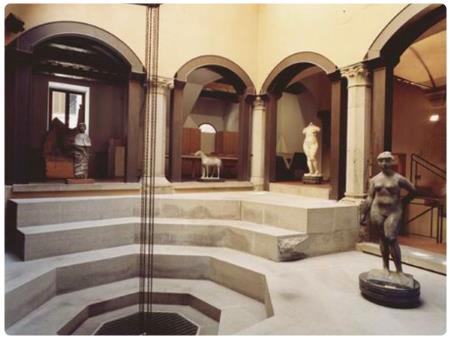 Marino
Marini was an artist from Pistoia, born in 1901, one of the most
expressive sculptors in Italy. The documentation center houses an important
collection of the artist, including paintings and sculptures and thematic
paths that allow the visitor to learn about art and its expressions. You
will be able to visit, for example, the corridor of female nudes, inspired
by the goddess of Etruscan fertility Pomona, a figure on which the Marino
Marini was an artist from Pistoia, born in 1901, one of the most
expressive sculptors in Italy. The documentation center houses an important
collection of the artist, including paintings and sculptures and thematic
paths that allow the visitor to learn about art and its expressions. You
will be able to visit, for example, the corridor of female nudes, inspired
by the goddess of Etruscan fertility Pomona, a figure on which the
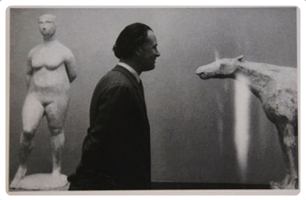 Marini
has concentrated much of his expressive art. Then there are the horses of
Marini, the strongest symbols of his art. Famous in the city is its'
Miracle', located in the inner courtyard of the Town Hall of Pistoia.
Several other cities in Italy and Europe host art trails dedicated to him,
including the Marino Marini Museum in Florence (Piazza San
Pancrazio). Marini
has concentrated much of his expressive art. Then there are the horses of
Marini, the strongest symbols of his art. Famous in the city is its'
Miracle', located in the inner courtyard of the Town Hall of Pistoia.
Several other cities in Italy and Europe host art trails dedicated to him,
including the Marino Marini Museum in Florence (Piazza San
Pancrazio).
Top
Puccini Park of Pistoia
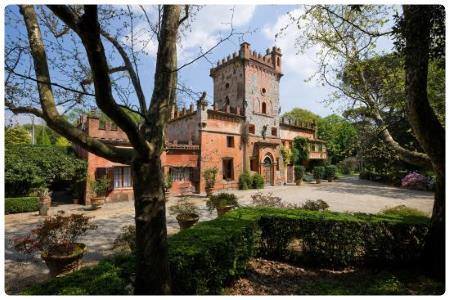 The
Puccini park unfortunately appears today as a small green
corner of the center of Pistoia, which however has lost the charm originally
attributed to it. The family of Niccolò Puccini realized it in the
first half of the nineteenth century, in the plot in which Tommaso, his
father, had previously built the so-called' Villone', a villa built with the
earnings derived from the profession of doctor. The garden was developed to
accommodate several buildings, which made it really unique: the Pantheon
to the Illustrious Men, the Temple in Pythagoras and to follow
other buildings dedicated to science, industry, or sculptures representing
important men such as Dante, Michelangelo, Galileo Galilei
or Carlo Linneo, all with the aim of enhancing the historical,
cultural and scientific progress in Italy. The park is also linked to
Filippo Pacini, the scientist from Pistoia, who recognizes the
identification of the cholera vibrion and tactile corpuscles, which in the
villa could conduct the first anatomical and histological research, thanks
to a microscope donated by Puccini himself. When Niccolò died, the park was
split up and decayed; today it is still possible to find the' medieval
castle' building with its crenellated tower and other buildings which,
however, have been allocated to another role. Inside the park there is the
Pistoia Music School and the Italian Academy for organ music....
Read on the
Puccini Park in
Pistoia. The
Puccini park unfortunately appears today as a small green
corner of the center of Pistoia, which however has lost the charm originally
attributed to it. The family of Niccolò Puccini realized it in the
first half of the nineteenth century, in the plot in which Tommaso, his
father, had previously built the so-called' Villone', a villa built with the
earnings derived from the profession of doctor. The garden was developed to
accommodate several buildings, which made it really unique: the Pantheon
to the Illustrious Men, the Temple in Pythagoras and to follow
other buildings dedicated to science, industry, or sculptures representing
important men such as Dante, Michelangelo, Galileo Galilei
or Carlo Linneo, all with the aim of enhancing the historical,
cultural and scientific progress in Italy. The park is also linked to
Filippo Pacini, the scientist from Pistoia, who recognizes the
identification of the cholera vibrion and tactile corpuscles, which in the
villa could conduct the first anatomical and histological research, thanks
to a microscope donated by Puccini himself. When Niccolò died, the park was
split up and decayed; today it is still possible to find the' medieval
castle' building with its crenellated tower and other buildings which,
however, have been allocated to another role. Inside the park there is the
Pistoia Music School and the Italian Academy for organ music....
Read on the
Puccini Park in
Pistoia.
Via del Villone
Area: Centre
Pistoia
Top
Ostelli Pistoia
Ostelli Italia
Auberges de Jeunesse Italie
Carte de Pistoia
Karte von Pistoia
Mapa Pistoia
Map of Pistoia
Carte de la Toscane Karte von Toskana Mapa Toscana Map of Tuscany
Carte d'Italie
Karte von Italien Mapa Italia Map of Italy |
